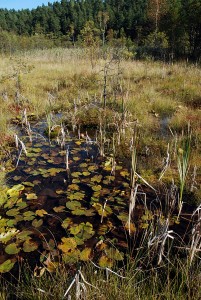Mechowiska Sulęczyńskie Nature Reserve established
On 25th November 2014, a decree establishing the Mechowiska Sulęczyńskie Nature Reserve appeared in the Official Journal of the Pomorskie Voivodeship (see FILES tab).
The reserve with an area of 22.58 hectares is located in the village of Sulęczyno, in Suleczyno Commune, Kartuzy County within the Pomorskie Voivodeship. The reserve is located within Natura 2000 site, Mechowiska Sulęczyńskie PLH220017. The reserve covers lands owned by the State Treasury as well as lands which belong to the Naturalists’ Club (we informed the readers about this purchase in previously published news and also within the Bociek bulletin).
The reserve includes parts of northern and central part of the peatland complex, the entirety of which is covered by Natura 2000 Mechowiska Sulęczyńskie PLH220017. The borders of the reserve were established according to the natural values of the area as well as in consideration of the ownership statuses (most of the private land located within the Natura 2000 Mechowiska Sulęczyńskie is not protected as a nature preserve). Northern part of the reserve is a spring-fed area in its nature, while the central part covers the remains of the high peat with numerous post excavation pits and dikes. This part of the reserve is supplied by waters flowing at the slopes which surround the bog. The entire peatland area evolved on the lacustrine chalk layer.
The outstanding natural beauty values of the Mechowiska Sulęczyńskie Natural Reserve are determined by very well preserved diverse vegetation, in particular, the presence of many species of protected and rare plants. The most valuable components of the vascular flora include: Liparis loeselii, Hammarbya paludosa, group of taxons of Dactylorhiza, among others: D. russowii, D. traunsteinerii, D. incarnata i D. majalis, Marsh Helleborine Epipactis palustris, Stellaria crassifolia, Carex dioica, C. demissa, C. lepidocarpa and among bryophytes: Drepanocladus vernicosus, Blandow’s bogmoss Helodium blandowii, Cinclidium stigium, Paludella squarrosa, Scorpidium scorpioides and large group of peat moss Sphagnum. The flora of the reserve has numerous glacial relicts found in Poland’s dispersed localities, and calciphilous species – because of the habitat conditions.
The flora is represented by well-developed and preserved mosses such as, among others, Menyantho – Sphagnetum terestris, Caricetum lesiocarpae, Caricetim diandrae as well as rare nationwide calciphilous: Eleocharitetum quinqueflorae and eutrophic Campylio – Caricetum dioicae. Some of the moss phytocoenoses is currently dominated by common reed and bulrush.
However, the dominant part is played by the phytocenoses which represent the 7230 natural habitat. The mentioned habitat includes the species from the Annex II of the Habitats Directive: Liparis loeselii and Drepanocladus vernicosus.
The creation of the reserve is the fulfillment of the naturalists’ demands who have for decades highlighted the unique qualities of the area, pointing to it as “an object requiring necessary protection as a nature reserve,” which couldn’t be done in the past mainly because of the private ownership status of the land. Secondary succession processes on the peatlands, especially the growth of shrubs and reeds have a negative impact on photophilous bog species.


This text is also available in: PL













